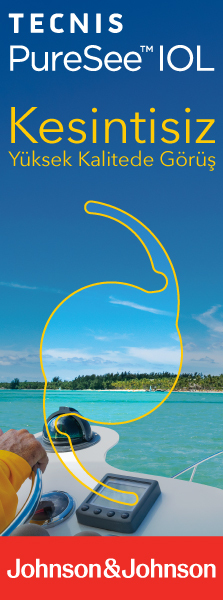TJ-CEO
2009 , Vol 4 , Num 1
Comparison of Intraocular Lenses in Terms of Ocular Aberrations
1Ankara Mesa Hastanesi, Göz Kliniği, Ankara, Doç. Dr.2Ankara Gazi Devlet Hastanesi, Göz Kliniği, Ankara, Uzm. Dr. Purpose: To show the differences in aspheric and spheric Alcon SN platform lenses in terms of high order aberrations and to find out wheter we achieve the expected results with the aspheric lenses.
Materials and Methods: In this retrospective comparative study, 34 eyes which has undergone uneventfull cataract surgery are included. In group 1, spheric SN60AT lenses were implanted in 20 eyes and in group 2, 14 eyes received aspheric SN60WF lenses. Ocular aberrations are measured at least 2 months after surgery, with Nidek OPDScan for a 6.0 mm pharmalogically dilated pupil using 6 th-order Zernike polynomials.
Results: In group 1, the mean root-mean-square(RMS) coefficient for the total high order aberration was 2.31±1.18. In this group, the mean RMS of the tilt, coma, trefoil, tetrafoil, spherical aberration and secondary astigmatism were 1.12±0.71, 0.43±0.32, 0.60±0.34, 0.35±0.47, 0.31±0.21 and 0.31±0.42 respectively. In group 2, the RMS coefficient for the total high order aberration was 1.62±0.62. The RMS of tilt, coma, trefoil, tetrafoil, spherical aberration and secondary astigmatism were 0.46±0.21, 0.20±0.11, 0.31±0.16, 0.10±0.07, 0.093±0.08 and 0.15±0.10 respectively. There was statistical difference in terms of tilt, tetrafoil and spherical aberration between 2 groups (p<0.05 according to Student’s t-test and Mann Whitney U test). There were more aberrations in the spheric SN60AT IOL group. There was no statistical difference between 2 groups in mean follow-up time, axial length, IOL power or corneal curvature.
Conclusion: The design of lenses affect the ocular aberrations after cataract surgery. Tilt, tetrafoil and spherical aberration were higher in spheric SN60AT group, thus an aspheric posterior optic design with thinner center, like SN60WF may be a better choice in appropriate eyes having cataract surgery. Keywords : Ocular aberrations, spheric intraocular lenses, aspheric intraocular lenses





